Table of contents
For many of us, “employee feedback” sparks memories of uncomfortable annual conversations with unapproachable managers. In today’s world, however, employee feedback has evolved into ongoing listening strategies that build trust between managers and employees. Regular employee feedback results in significantly higher engagement, with a plethora of attendant benefits. Let’s take a look at why employee feedback matters, some real-life employee feedback examples, and how managers can respond and take action to build a culture of listening.
The importance of employee feedback
The value of positive employee feedback is obvious. It reinforces the right behaviors, and it is directly linked to increased employee engagement and productivity. Negative employee feedback is equally important. When provided constructively, it reduces negative behaviors and helps employees understand their strengths and weaknesses. The right feedback, given at a critical juncture, can have a significant impact on behaviors, skills, and ultimately careers.
Employee feedback is an important tool for growth and development. Interestingly both positive and negative feedback can have positive outcomes.
The value of positive employee feedback:
- Reinforces desired behaviors
- Increases employee engagement
- Improves productivity
Negative employee feedback is equally important. When provided constructively, it:
- Reduces negative behaviors
- Helps employees understand their strengths
- Provides insight into how to address areas of opportunity
The right feedback, given at a critical juncture, can have a significant impact on behaviors, skills, and ultimately careers.
With the gig economy growing and more employees working independently, building connections between employees and managers is more important than ever. Employee feedback is critical to building these connections. For managers, listening to employee feedback and taking action is just as important as giving feedback.
7 types of employee feedback
Positive feedback
Positive feedback helps employees understand when they’re doing well and provides an opportunity to reward them for their efforts. Positive feedback is important because it can contribute to overall employee morale, enhance engagement, and increase job satisfaction and loyalty to the organization.
Coaching feedback
Coaching feedback focuses on shaping future behaviors. It means asking people t be constructively critical of their own performance rather than simply providing feedback to them. This approach applied to both positive and improvement-focused feedback.
Constructive feedback
Constructive feedback is a supportive way to improve areas of opportunity for an individual employee or for a team. It focuses on turning negatives (areas of opportunity) into positives by highlighting a new or better way. It can also be seen as a combination of constructive criticism and coaching.
Negative feedback
Negative feedback points out areas of opportunity for improvement and highlights only the things done incorrectly, whether they be attitudes, behaviors, or actions. The intention behind negative feedback is to correct these things so that they do not produce negative outcomes for the employee, team, or organization.
Upward feedback
Upward feedback is when employees provide their supervisors, managers, or executives with their observations related to the organization and their employee experience. This can include feedback about management style, operational processes, team or organizational performance, company culture, or behaviors. Upward feedback is the opposite of the traditional manager-to-employee feedback process.
Formal feedback
In contrast to other forms of feedback which can occur at any time, formal feedback is planned and integrated into an organization’s processes at precise intervals. Typically associated with assessment tasks, formal feedback includes measures such as: key performance indicators, competency assessments, review of achievements, and so on and is documented for both the employee and the organization.
Appreciation feedback
Appreciation feedback is a conversation between one person and another (or to a team), thanking them for their contribution, effort, or performance. It is a way to recognize achievements and is an important step in building trust and nurturing employee engagement.
Examples of employee feedback
While organizations vary widely and have different ways of providing employee feedback, the following examples offer some guidance that managers can use in providing constructive feedback.
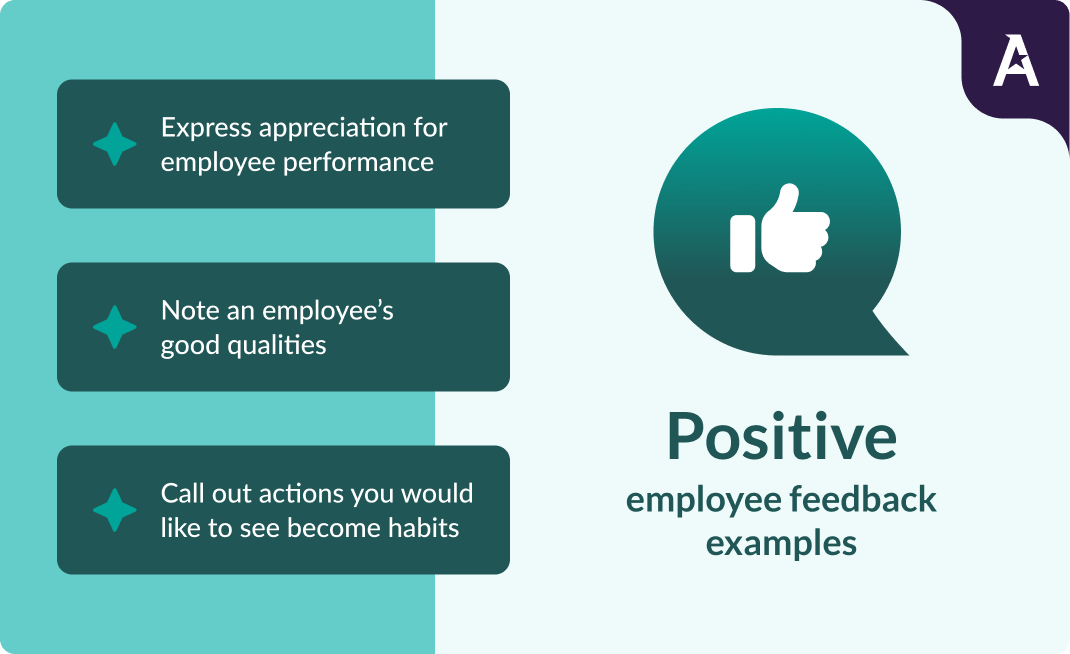
Positive employee feedback examples
Whether it’s a recognition of good work or acknowledgment of perseverance, there are many instances where managers can take the opportunity to provide positive feedback. Here are some examples:
1. Express appreciation for employee performance
“What a great job you did on the presentation yesterday! I hear the client was very pleased, and may significantly expand the project. Well done. I really appreciate all the hard work, creativity, and energy you put into it.”
When an employee succeeds, they should hear about it. Express your recognition of the right behaviors and celebrate positive results. If possible, be specific about skills, achievements, and business outcomes.
Employee success often goes unrecognized as managers can be complacent and forget to call out positive performance. We recently found that 58 percent of employees said their manager relationship would improve with more recognition. Showing appreciation reinforces the right behaviors, makes employees feel valued and motivated, and is directly linked to increased employee engagement.
2. Note an employee’s good qualities
“I noticed how well you responded to that customer’s concerns. You were patient, understanding, and resourceful. Customer support is an important part of our company brand, and you certainly displayed it.”
Let employees know what they are particularly good at, and what traits you appreciate. Tying good qualities to organizational values creates a line of sight to business results, and builds employee confidence.
3. Let employees know when they’re setting a great example
“Jane told me that she is using the new network tool to keep track of sales, based on your positive feedback on the application. Thanks for supporting our new technology, and setting a great example for others.”
When an employee does something that others should emulate, let them know. Colleagues tend to listen to each other, and setting a good example is the fastest way to incorporate the right behaviors into your workforce.
4. Call out actions you would like to see become habits
“Thank you for using a spreadsheet to keep track of all the project expenses. It was very helpful for the team and we were able to keep costs under budget. It was so effective, I’d like to use it on all our future projects.”
Positive employee actions are more likely to become habits if you call them out. 92 percent of employees agree when they’re recognized for a specific action, they’re more likely to take that action again in the future. Employees may not realize their efforts are valued unless they are recognized. When an employee’s actions are particularly important to job success, you should take the time to demonstrate the impact of their actions and suggest that the employee repeat them in the future.
5. Support employees when difficulties arise, and congratulate them when they persevere
“I understand there have been some very difficult days on the job due to the weather and short supplies. It’s remarkable how you have managed to keep everything running smoothly. I really appreciate your hard work and perseverance.”
Even the most successful businesses experience difficult times. It’s important to recognize employee resilience and congratulate them for their efforts. Acknowledging issues allows employees to open up about concerns they might have, which builds trust. This can be hard if the issues are personal rather than work-related, but in either case, let employees know that the way they’ve weathered the storm has been noticed and appreciated
6. Show appreciation for team performance
Recognizing individuals is important, but it’s also good practice to show your appreciation for teams as a whole. It encourages comradery and collaboration and helps each employee to see how their individual efforts contribute to the team’s overall success.
Appreciation can take many forms, from a simple public thank-you, to a more formal reward such as a gift card or special lunch just for your team. Whatever the approach, be sure to be specific about what you are showing appreciation for and recognizing so that those behaviors can be repeated.
7. Recognize overall performance improvements
When employees are putting in the effort, they want to know that it’s being noticed, and measured. Be sure to recognize and document overall performance improvements both informally during 1:1 conversations, and more formally during performance reviews. This demonstrates to the employee that their hard work is paying off.
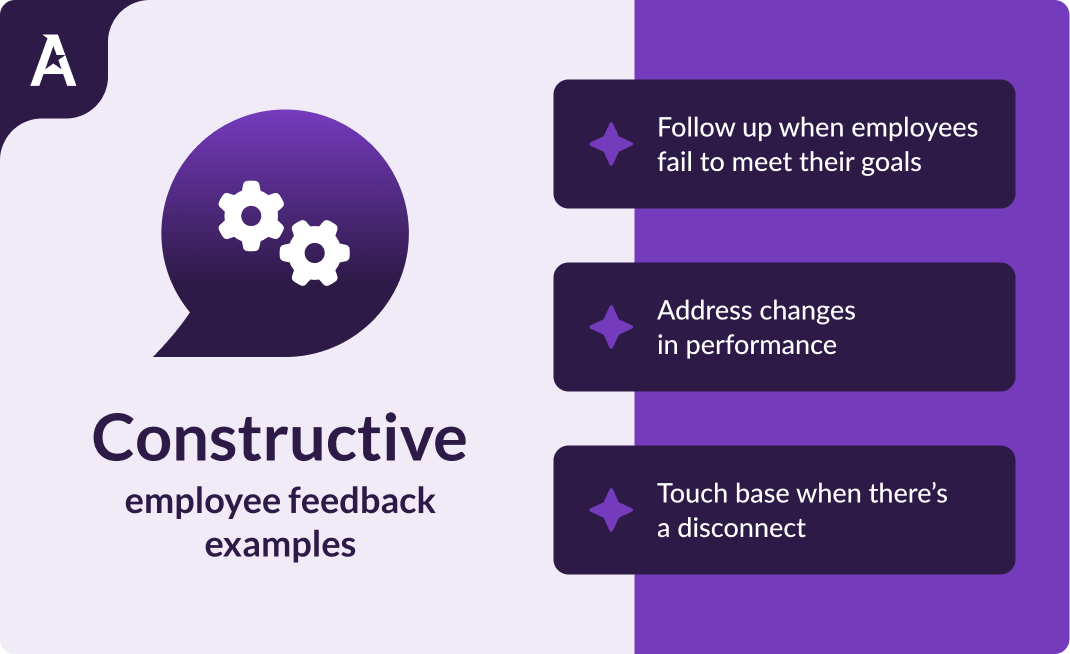
Constructive employee feedback examples
When things don’t go as well as planned, constructive feedback helps redirect employees into adopting more successful actions and behaviors. Let’s review some examples:
8. Handle problematic behavior
“Several of your colleagues have reported hearing you tell jokes in the lunchroom that they found offensive. This organization has very clear guidelines. Any comments or jokes that might cause offense to others are not appropriate and will not be tolerated.”
Problematic behavior in the workplace must be addressed immediately to maintain a culture of respect, tolerance, and anti-discrimination. However, managers should not assume that offense was intended, as acceptable behavior for one individual may not be acceptable to another. Feedback should not be used to punish or blame the employee. Feedback should provide clear, specific guidelines as to what is acceptable and unacceptable in the workplace, and why.
9. Follow up when employees fail to meet their goals
“We set performance goals to ensure that both you and our business succeed. Your goals are tied to organizational objectives and affect our overall results. I am concerned that you fell short. Let’s discuss why that happened and what changes we can make to ensure you succeed in the future.”
When an employee fails to meet goals, feedback should be provided as soon as possible to understand the underlying issue and get performance back on track. Connecting individual goals to business objectives is key. Encourage input and have a two-way conversation to ensure a common understanding of the importance of meeting goals and the reasons for falling short. Focus on the actions and behaviors that will boost performance and lead to future success.
10. Address changes in performance
“You are one of our top salespeople and your results are always excellent. Recently, however, I noticed a decline in your numbers. I was wondering if there is a reason for the change and if there’s anything I can do to help you be successful.”
Good managers will stay on top of business results and individual goals, and check in with employees immediately if there is a change in performance. The goal is to uncover the reason behind the change and provide support to get performance back on track. Start with positive feedback to show that you recognize and appreciate previous efforts. This provides a launching pad for discussing changes in performance and what the employee and manager can do to turn things around and ensure success.
11. Touch base when there’s a disconnect
“The results of the IT project were not as successful as I had hoped. The team thought that you were going to be more involved and take on more responsibility. I would like to hear your perspective on the project and discuss how we can avoid misunderstandings in the future.”
In today’s digital world, team disconnects happen all too frequently. Managers should avoid personal observations but focus on the impact of the problem. Make sure there’s a clear understanding of team responsibilities, and the importance of being on the same page. Solicit feedback to understand why the disconnect occurred, and suggest strategies to ensure it doesn’t happen again.
12. Have a productive discussion about errors
“Unfortunately, the marketing materials that were recently mailed had the wrong logo. I understand that digital assets can be hard to manage but I thought we had a clear process in place. I’d like to get your perspective on how the mistake happened and how we can avoid it in the future.”
Mistakes happen, and, while no one likes to talk about them, without constructive feedback they are likely to happen again. Employee feedback should not be about finger pointing. Instead, have a productive discussion about how the error happened, the impact, and how to address it. Most importantly, you want to ensure your employee learns from the mistake so that it is not repeated in the future.
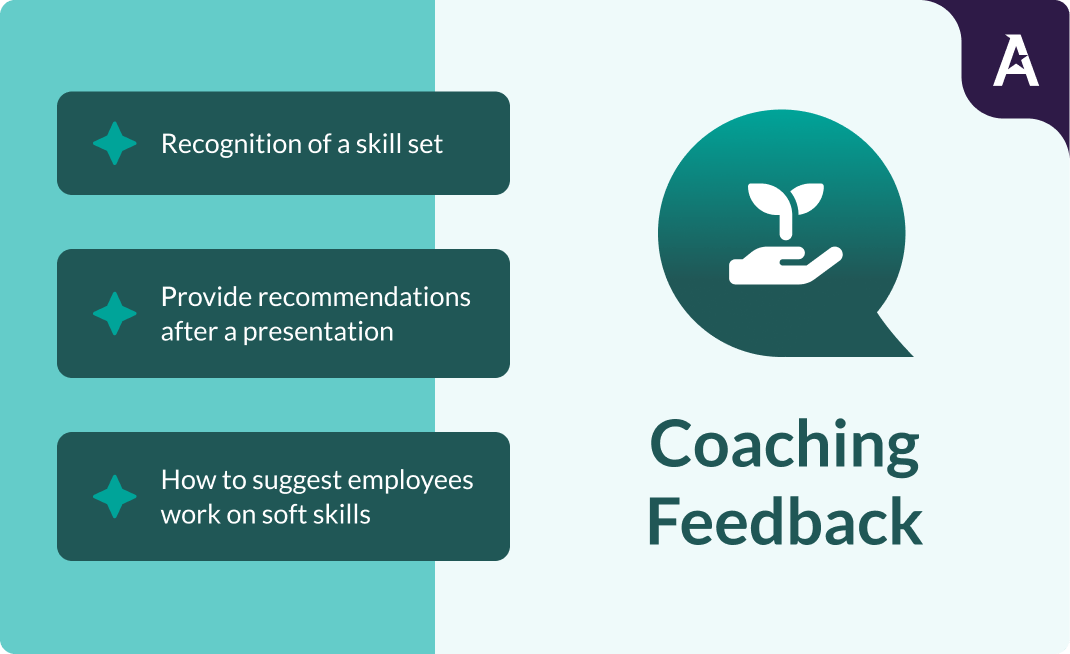
Coaching feedback
13. Recognition of a skill set
During coaching moments, recognize the skills (existing or recently developed) that you see the employee demonstrating. If it’s something new, congratulate and reward them for taking the time to learn or develop a new skill. If it’s something existing they’re applying well to their role, show them that you value what they bring to the team by sending them a recognition through your employee engagement platform.
14. How to suggest employees work on soft skills
Not all employees have an innate understanding of soft skills — personal attributes that enable someone to interact effectively and harmoniously with others. Moreover, they may not understand why they’re important.
For employees with a gap in this area, take the time to demonstrate how working on their interpersonal skills can help them be more effective in their day-to-day interacting with other employees, departments, the organization, and clients or customers. By being logical and analytical in your reasoning, it may help employees who work better in a more data-focused approach adopt soft skills to complement their approach to work.
15. Provide recommendations after a presentation
When an employee or team gives a presentation, give it your full attention and take notes as needed. The best time to provide feedback and recommendations is directly following the presentation, once you’ve had a chance to think back on what was said and shown, and have reviewed your notes.
Sharing your feedback in a constructive way demonstrates that you are invested in the employee of team’s success and are able to add value by helping them develop their ideas to the next level.
16. Acknowledge contributions to company culture
Nurturing company culture is important. This is the environment your employees work in each day and you want to ensure that it’s setting the right tone and that they’re champions of the corporate values.
When you see or hear about an employee taking an action, encouraging or demonstrating a desired behavior, recognize them. Be specific in what you are recognizing and why so that they make the connection back to the elements that form your company culture.
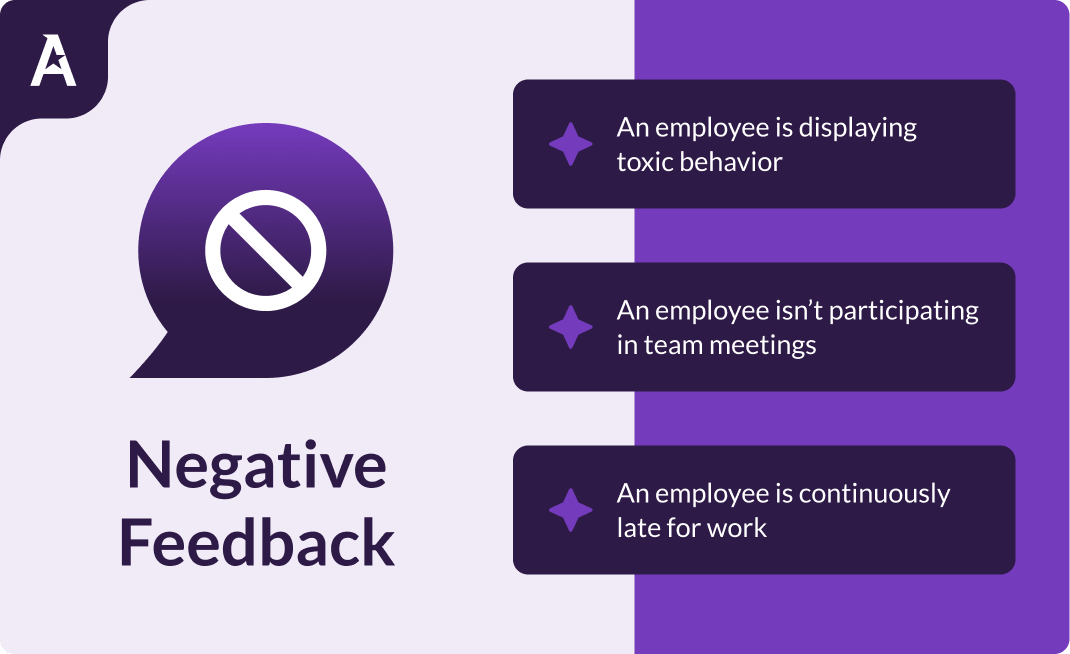
Negative feedback
17. An employee is displaying toxic behavior
If you witness or hear of an employee displaying toxic behavior, address it right away. Uncovering the root cause is key to correcting the issue and preventing the negative speak or activity from interfering with the success and workplace experience of other employees.
18. An employee is continuously late for work
Some individuals just can’t seem to make it to work on time and in many organizations, this is an issue that needs to be addressed. Once again, uncovering the reason is important. It could be that they have commitments such as dropping children off at school that make getting to work on time a challenge. Or perhaps their method of transportation is unreliable or inconsistent.
Whatever the reason, find a way to work with the employee to make their workday more flexible to meet their needs without impacting their team. Or, have a discussion around expectations and how you can work together to correct the issue.
19. A drop in productivity
When a manager sees a drop in employee productivity, they should start by discussing it with their employee. There are many reasons this can happen and without uncovering the cause, you won’t be able to help them address their performance.
Begin by listening to the employee and asking questions. Perhaps there is a process or operational issue preventing them from being productive. Or, there could be a personal reason behind the change. Before making assumptions and taking action, be sure that you have the full picture and offer ways to address the issues behind reduced productivity.
20. An employee isn’t participating in team meetings
Some employees are less comfortable speaking in front of a group, even if it’s just a few other people on their own team. This is often the reason that some employees don’t speak up during team meetings. They may feel uncomfortable sharing their ideas openly, or perhaps other members of the team are taking the majority of the air space.
Speak with the employee 1:1 before calling on them in a meeting to help you uncover the reason behind their lack of participation
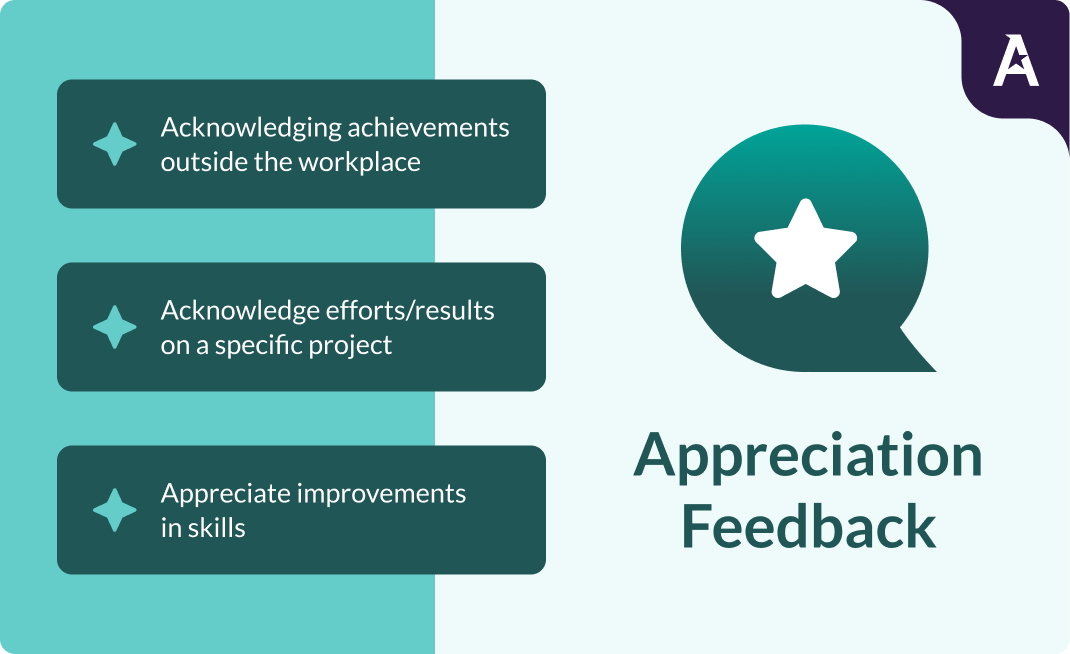
Appreciation feedback
21. Acknowledging achievements outside the workplace
Employees are more than just people who work at your organization. They have hobbies, interests, and achievements outside of work.
When a team member has a personal achievement or milestone in their personal life, acknowledge and celebrate it at work. It shows employees that they are seen as individuals, not just as workers. These achievements can include things like completing a professional development course, getting married, moving into a new home, starting a family, volunteering for an important cause, and more.
22. Acknowledge efforts/results on a specific project
Recognition should be frequent, so take the opportunity to acknowledge an employee’s efforts on each project they work on. Recognition should also be specific, so be sure to reference the work done and why their contributions were important and impactful.
23. Appreciate improvements in skills
When you see an improvement in an employee’s skill set, recognize it. Show them that you’ve noted their hard work and its positive results. This will encourage the employee to continue to work on developing their skill set to be more productive and further their career.
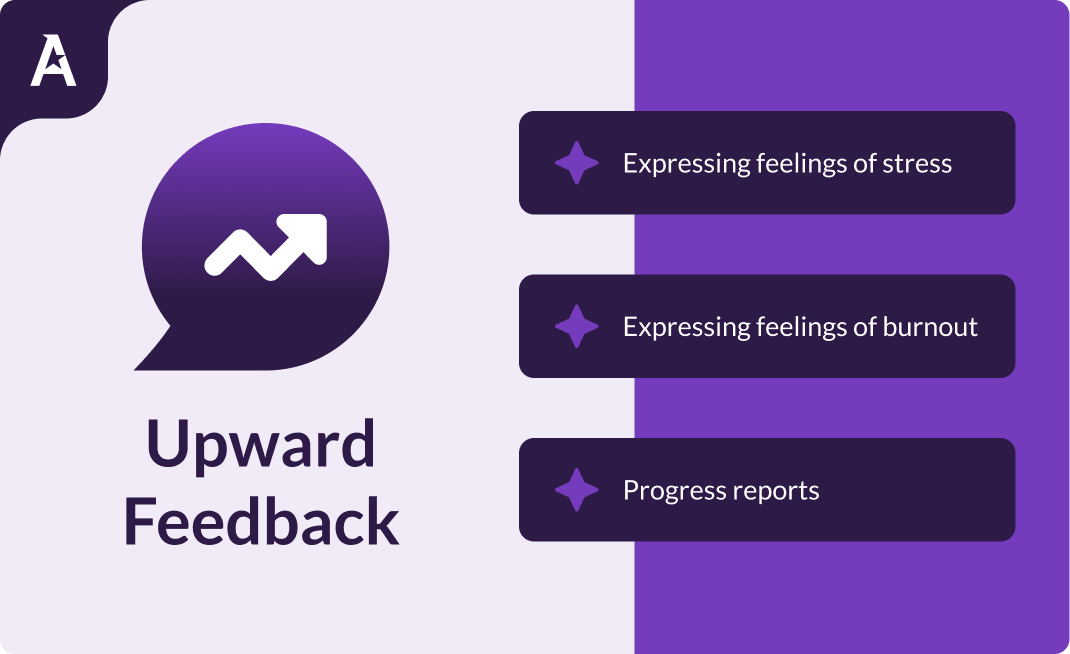
Upward feedback
24. Expressing feelings of stress
Employees should feel empowered to express feelings of stress at any time to their manager. For some employees, they may have a stressful day that they need to talk through. For others, feeling of stress may be more persistent and may require their manager to step in to address the cause.
Be sure to create opportunities for your team members to feel comfortable approaching their managers to talk about stress in the workplace, and equip people leaders with the skills to help them address the issues with empathy and kindness.
25. Expressing feelings of burnout
Similarly, employees may begin to feel burnt out, particularly if they’ve experienced prolonged feelings of stress. Employees should feel comfortable speaking to their managers about burnout and should be met with constructive ways to help them manage their workload or make adjustments to alleviate stress and improve their wellbeing.
26. Progress reports
Every employee should know how they’re performing in the eyes of their manager and organization and should be provided with a clear path on how to continue to improve.
Regular 1:1 meetings are important, but more formal progress reports should also be conducted and documented so that employees and their managers can benchmark their success and identify any areas for improvement.
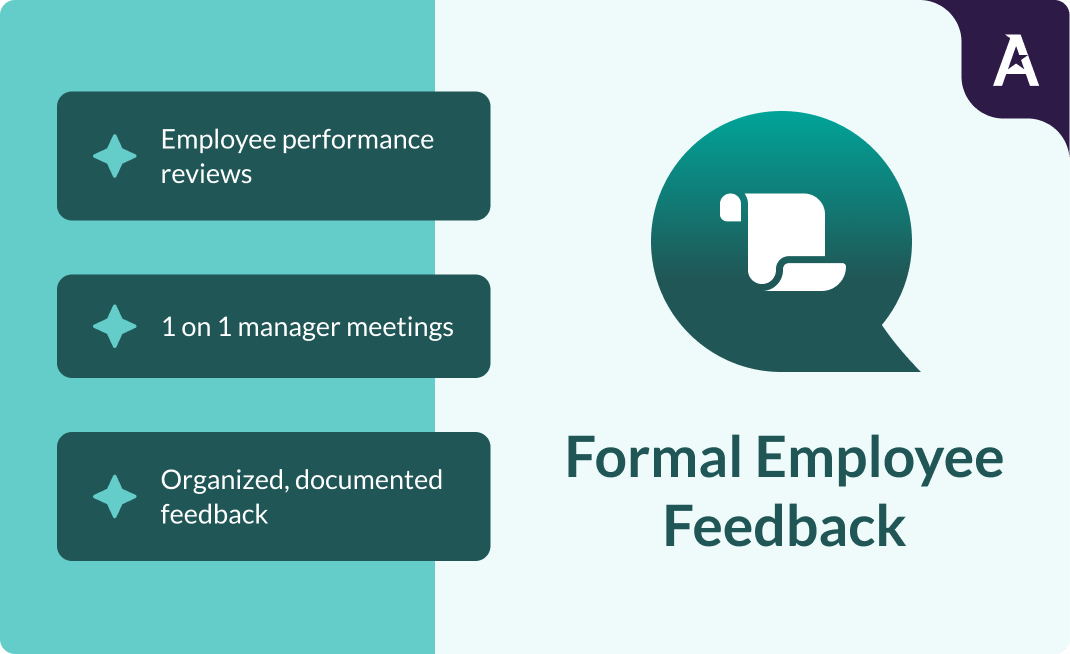
Formal employee feedback
27. Employee performance reviews
Employee performance reviews should be set at regular intervals so that the employee and their manager can review and reflect on their progress and productivity. It is an opportunity for employees to highlight their achievements and for managers to constructively discuss areas where employees can improve.
These meetings should be documented and made visible to both the manager and employee.

28. 1 on 1 manager meetings
Whether in-person or virtual, 1:1 meetings between managers and their employees should be at regular intervals and occur more frequently than performance reviews. They also tend to be less formal than these longer performance-evaluating meetings. The time during 1:1 manager meetings should be spent addressing what’s on the employee’s to-do list, how they’re feeling about their workload, and to uncover an issues as they arise.
29. Organized, documented feedback
No matter how formal the meeting, each should be documented in some form, with speaking points, take-aways and action items captured so that both the employee and their manager understand the next steps.
Feedback documented should be shared between both parties and captured within a formal employee performance management system as needed.
How to provide feedback to employees
Whether positive or negative, there are many ways of providing constructive employee feedback. The list below outlines best practices for employee feedback that apply to colleague and manager feedback as well.
Make it timely, specific, and relevant
Providing employee feedback on a project that happened six months ago will have little impact on either the employee or the project. Instead, give feedback right away. Top-performing employees who feel their efforts are unrecognized may disengage and look for other opportunities. Employees who are not performing well will continue to struggle until feedback points them in the right direction.
Specific and relevant feedback gives employees a clear understanding of the skills and behaviors that lead to success. Employees want to understand exactly what it is they are doing right — or wrong — and what changes they should make. A great way to do this is to keep the focus of the employee feedback on business outcomes; for example, “Because you did such a great job on this project, the client has increased their budget for our services.”
Make it a two-way process
Eliciting thoughts and reactions from employees allows a manager to understand how the feedback has been received, and the impact it will have moving forward. Asking questions like, “What are your thoughts?” and ”How do you feel you performed?” will lead to valuable insights and build trust.
Similarly, feedback between peers is important. Colleagues are often the best positioned to see others’ behaviors, performance, and skills. Providing positive feedback to colleagues builds stronger relationships and leads to top-performing teams.
Handle positive and negative feedback differently
Positive employee feedback is a joy to provide, and there are many ways to recognize and reward a job well done. A monetary bonus, team event, or simply providing social recognition are all great methods. Managers should find out what teams and individuals value most highly to ensure their rewards and recognition strategies are getting the highest motivational impact.
Negative feedback is more difficult to provide and should be addressed sensitively. Never provide negative feedback in public. Choose a private setting and do it face-to-face so you can have an honest, constructive conversation. Don’t pile on the criticism; instead, be very specific about the issue(s) and offer examples of how to improve. It often helps to write down what you are planning to say before the meeting, but practice it ahead of time to avoid reading off a piece of paper. Provided honestly and sensitively, negative feedback will not make an employee feel punished, but instead will lead to improved skills and behaviors.
Go beyond annual reviews
Annual reviews are an opportunity to look back over the previous year and assess accomplishments, skills, and areas for development. But packing everything into a single annual review can be overwhelming and hard to process. Giving and receiving employee feedback throughout the year offers real-time data on employee performance. Managers should provide feedback regularly, and open up channels to encourage employees to do the same.

Listening to employee feedback
For managers, listening to employee feedback is just as important as giving feedback. Providing a platform to share thoughts and ideas is critical to building and maintaining employee engagement. It’s also a great mechanism for managers to better understand their workforce and potentially avoid costly errors and ineffective processes. Leverage the following listening tools:
- Pulse surveys include a short series of questions that are quick, easy to answer, and, ideally, distributed to employees regularly. With employee-centric topics like role, communication, and work environment, they provide a check on the health of an organization.
- Chatbots are becoming more and more prevalent. An HR chatbot, like Achievers’ Allie, will initiate employee engagement conversations and confidentially invite employees to share their feelings and observations about their job.
- Annual surveys provide an in-depth analysis of an organization and are useful for measuring engagement and identifying issues. The real value, however, comes from how a company uses the results: incorporating changes and communicating results back to employees.
In addition to scheduled employee feedback mechanisms, managers should incorporate impromptu opportunities for employees to provide their input. Engage in active listening and be prepared to hear both the good and the bad. When employees feel that they can provide feedback without negative consequences, they will be much more likely to speak openly and honestly.
Following up on employee input is equally important. Thank employees for their feedback and let them know what actions are being taken. Change can often take a long time to implement in an organization, but initiating and communicating a plan will let employees know that their feedback has been heard and valued.
“Thank you for pointing out the concerns you have with the new online tool. We rely on input from employees to ensure our technology is working effectively. I have escalated the issue and will let you know when a solution is in the works.”
“I really appreciate your feedback! I agree that the team did an outstanding job and I plan to celebrate the results at the next staff meeting.”
Establish a culture of listening and reap the rewards
Keeping a feedback channel open allows employees to flag issues when they arise and the chance to express satisfaction when things go well. It also allows you to address concerns raised by feedback in real time. Achievers’ Listen is a solution that gives managers and HR professionals insights into their workforce through active listening and helps them turn feedback into action.





